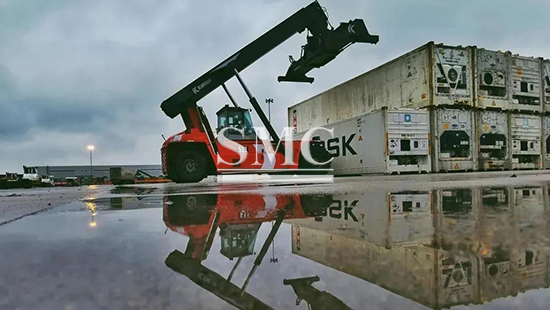Affected by the new crown pneumonia epidemic, the coastal port enterprises in China have been blocked to a certain extent from the collection and transportation channels. As a carrier for the transportation of frozen meat, seafood, fruits and other goods, refrigerated containers (including refrigerated containers, referred to as refrigerated containers) are difficult to store and transport in some areas. Will the “vegetable basket” of the people be affected? What ripple effects will the shipping market have? What countermeasures have each port taken?

Status quo-structural imbalances in reefer storage, some ports are close to saturation
Since the outbreak, China’s catering industry has been greatly affected. During the Spring Festival, the sales of frozen seafood including shrimp in many places fell by nearly 90%, and some aquatic products trading markets were in a halt. Demand for imported seafood, frozen meat and other goods decreased significantly compared with the same period of previous years. At the same time, most port truck drivers have not resumed work during the Spring Festival. Taking Ningbo as an example, there are 1,660 truck companies, and only 5% of the 25,000 truck drivers are locals. During the Spring Festival, there were about 800 drivers staying in the city, and the phenomenon of “hard to find a car” appeared in the market. As a result, a large number of refrigerated containers arriving in Hong Kong in January 2020 were not picked up and could only be stored at the port. In early February, Ningbo Zhoushan Port, Tianjin Port, Shanghai Port and other ports had a tight storage space for refrigerated containers, and the storage capacity of some ports was close to or reached saturation.
It is understood that the refrigerator needs to be connected to a dedicated refrigerator socket. The voltage is generally a three-phase four-wire 400V class voltage. Therefore, the storage of refrigerators is not only related to the storage space, but the number of refrigerator sockets is also a determining factor. The port area where the storage capacity is close to saturation is mainly due to the small amount of reefer container outlets.
Except for Ningbo Zhoushan Port, Tianjin Port and Shanghai Port, there is still ample surplus in the storage capacity of reefer containers in other ports in China. Dalian Port Yidu Cold Chain Co., Ltd. has a 160,000-ton refrigerated warehouse and a 100,000-square-meter refrigerated container yard in Dalian’s largest professional cold-chain logistics center along the coast of China-Dalian Dayao Bay Bonded Port Cold-chain Logistics Center. During the epidemic period, the storage volume was 11,000 tons and the storage volume was 10,000 tons. According to the data of Liaoning Port Group, as of February 18, the company’s inventory was 87 thousand tons, and the cold storage utilization rate was 62%. Guangzhou Port Nansha Port District Phase I, Phase II and Phase III terminals have a total of more than 5,000 refrigerated container sockets, with a storage capacity of nearly 8,000 TEUs, and the storage yard usage accounts for about 10%. As of February 17, the remaining storage capacity was 7,000 TEUs. . As of February 24, Shandong Port Qingdao Port Qianwan Port area has a total of more than 11,000 refrigerated container sockets, the utilization rate of refrigerated containers is 40%, which can meet the customer’s storage and transportation needs of frozen products.
It is worth mentioning that since the outbreak, each port has been focusing on prevention and control of the epidemic, and on port production. In the absence of manpower and limited land traffic, it has actively protected the supply of civilian bioenergy resources such as energy and food for the people. On February 7, three trucks full of Yili Group’s 96-ton dairy raw materials rushed out of Tianjin Port. After further processing, these batches of raw materials will be used as emergency supplies to assist Wuhan. On February 10th, Shanghai Port Group guaranteed 8 containers and 197 tons of frozen pork to Wuhan. On February 14th, Ningbo Zhoushan Port truck drivers actively responded to the call and shipped fruits, vegetables, grains, oil and other materials to Ningbo’s large supermarkets.
Airlines-charge congestion surcharge
Refrigerators have always required electricity to keep them cold and have high storage requirements. In addition, reefer containers generally carry food, have a limited shelf life and a high value, which can easily cause damage to the whole box or the entire ticket. The storage of reefer containers at the terminal will also bring additional cold insertion fees and port monitoring service costs to shipping companies.
Therefore, as the destination port is a refrigerated container outlet or a refrigerated container with a site close to the saturated port area, in early February, major liner companies have successively adopted more cautious measures such as collecting surcharges and transferring to other ports.
Maersk announced that from February 7th, a congestion fee of US $ 1,000 per container will be charged for refrigerated container cargo entering Shanghai and Tianjin Xingang to cover the additional cost of replanning routes. The effective date of some routes is March 6; APL Announced that on the 14th, refrigerated containers exported to Shanghai Port, Ningbo Port and Tianjin Xingang will be charged a port congestion surcharge of US $ 1,250 per container; Liner Shipping and other liner companies also announced that they will immediately charge an additional surcharge of US $ 1,000 per container.
Japanese liner company Ocean Networks Shipping (ONE) notice to customers states that in order to pay for the cost of rescheduling cargo and refrigeration-related costs, all refrigerated containers shipped to Shanghai Port and Tianjin Xingang will be levied per The $ 1,000 congestion surcharge for containers will remain in effect until March 14th, and may be unloaded at another port without prior notice. If there is a refrigerator socket, every effort will be made to arrange subsequent shipment to the original port of destination.
Mediterranean Shipping stated that it would invoke Article 19 of the bill of lading to give it the right to leave the goods “any place or port deemed safe and convenient by the carrier” and to charge any additional costs incurred for this purpose.
In addition, in order to minimize the damage to the refrigerated container, major liner companies recommend that customers consider transferring the goods to ports in China such as Liaoning, Shandong, Fujian, Jiangsu, etc., or foreign ports such as Busan Port in South Korea. Among them, Maersk allows customers to change the destination port free of charge. In Shanghai Port and Tianjin Port, an empty ship will be arranged to dock at the dock as a reefer container site. COSCO SHIPPING recommends that customers who have already arrived in the reefer container arrange delivery as soon as possible to ease the pressure of cold plugging at the terminal; it is recommended that customers who have not arrived in the reefer container pay close attention to the cargo dynamics and provide services for changing the destination port.
At the same time, insurance companies are also in the process of claiming for damaged cargo in stranded reefer containers at Asian terminals. It is reported that the potential claim amount may amount to tens of thousands of dollars per TEU.
Port-Off-site pick-up
On February 16, 32 Maersk refrigerated customs clearance boxes were transported to the Zhenghe Wharf of Taicang Port, Suzhou Port by Yangtze River Waterway, which means that customers can directly bypass Shanghai Port to pick up boxes in Taicang Port.
According to the relevant person in charge of the production business department of Shanghai Port Group, this is the introduction of off-site pick-up service of imported refrigerated customs clearance boxes by Shanghai Port Group by taking advantage of “public water reform” and “transit to iron”. In order to complete this off-site pick-up, Shanghai Port Group actively negotiated with Maersk, the owner’s customer and other parties to change the refrigerated customs clearance box originally transported by road from the port to the direction of Jiangsu to water transport, which solved the current road transport and port The shortage of reefer container yard resources also provides new channels for customers with direct links to the service network of ports and shipping companies, shortening land transportation distances, reducing costs, and ensuring the supply of refrigerated materials.
The way to deconsolidate is not only to carry boxes off-site, but also to expand storage capacity. From February 8th to February 14th, the 4th batch of 819 reefer container sockets in Tianjin Port have power transmission conditions and are put into use. In addition to the 404 new reefer container sockets added on January 16, Tianjin Port Group completed a total of The storage capacity of 1,223 refrigerated containers was expanded. On February 24, the reporter learned from Tianjin Port Group that the current storage capacity of Tianjin Port’s reefer container terminal has increased by 30%, the overall port capacity has increased by 50%, and the reefer container handling capacity can meet the Tianjin port’s handling requirements. There is a surplus. At the same time, Tianjin Port stated that each container liner company could arrange the refrigerated containers that had been stranded overseas in the early stage to be picked up and unloaded at Tianjin Port.
Ningbo Zhoushan Port, which is difficult to find with one car, is actively coordinating with the port authorities to temporarily store imported refrigerated containers in the cold outside the port under the circumstances of poor road transportation, shortage of truck drivers, and the factory has not resumed work. Chain storage yard, rebuilding the refrigerated container site, and temporarily raising the storage height to ease the site storage tension; on the other hand, the use of “port + Internet” and big data to help external truck drivers resume work. It is understood that Ningbo Zhoushan Port Group divides drivers into three categories: high-risk, medium-risk, and low-risk areas according to the region. It uses the e-commerce platform of the E-port Connect company to push letters to each driver, and issues a call for rework. Driver rework provides classification guidelines.
On February 14, a total of 1691 drivers for trucks outside Ningbo area. At 00:00 on February 22, Ningbo Reworked Trucking Company has reached 869, with 15,000 trucks available, 7344 active truck drivers are on duty, and the daily container traffic reaches 15,000. On this basis, Ningbo Zhoushan Port Group unifiedly coordinated the remaining storage capacity of reefer containers in Hong Kong, continued to deepen internal potential, and made full and effective use of reefer container yards in the whole port area; all terminal companies increased their efforts to sparse ports and gave priority to protection Reefers were opened to the port to maximize the release of reefer containers in the port area.
Under the premise of comprehensive resumption of work and production, ports with large surplus storage capacity will focus on promoting the enhancement of reefer storage capacity to ensure the smooth reception and unloading of reefer containers arriving in China. Shandong Port and Qingdao Port actively use spare refrigerator plugs to clean up refrigerator storage yards to ensure that as many storage bins for refrigerated containers as possible are provided; assign specialists to interview import customers on a regular basis to understand customer needs and evacuation difficulties, and ensure timely evacuation; Leverage the advantages of surrounding cold storage to provide customers with warehousing services.
Industry insiders said that with the gradual control of the epidemic, the increase in the domestic pharmaceutical industry and the demand for fresh fruit will stimulate the development of cold chain logistics to a certain extent. For some ports, the tension in the future will still be a period of relief. Ports should actively ensure the resumption of production and production, further alleviate the pressure of empty container transportation and storage, improve the supporting service functions of cold chain transportation, and ensure the efficient and smooth operation of civilian cargo such as frozen cargo during the epidemic period. It is expected that by the end of March, China’s refrigerated container transportation will return to normal.
Guest contributors are welcome at the Alloy Wiki.It is a weekly wiki and guide on alloy information and processing technology, while also about the vast array of opportunities that are present in manufacturing. Our team of writers consists of a Machining Material Supplier / Machinist / Tool and Die Maker, a Biomedical Engineer / Product Development Engineer, a Job Development Coordinator / Adjunct Professor, and a President and CEO of a manufacturing facility.
Link to this article:It's Difficult to Store and Transportation Refrigerated Containers, How to Deal With It?
Reprint Statement: If there are no special instructions, all articles on this site are original. Please indicate the source for reprinting:Alloy Wiki,thanks!^^


